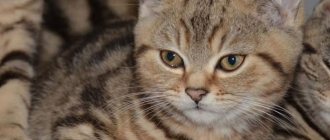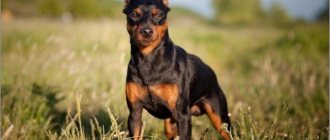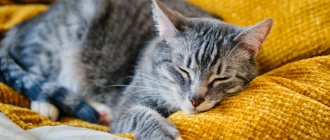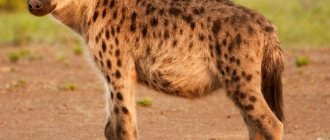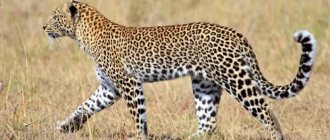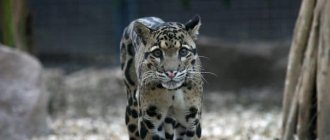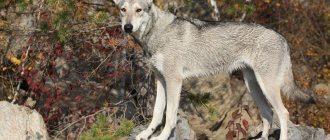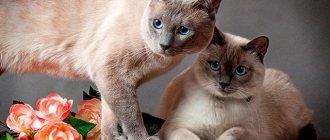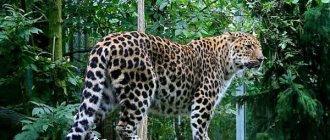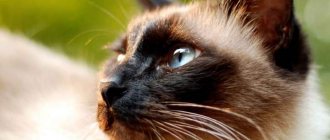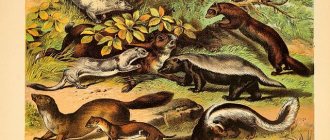Hybrid breeds
Hybrids are animals obtained by crossing wild and domestic cats.
Bengal
Selection work on Bengals began in the 60s of the 20th century. The hybrid was formed from the union of Asian small leopards with domestic pets. The fourth generation offspring, starting from the wild ancestor, is considered a domesticated species.
The first specimens of Bengals had a characteristic “golden” color - black markings on an orange background. Subsequently, animals with different colors were bred:
- color silver – silver background;
- snowy - with a light colorpoint body;
- marble - with spots forming a continuous pattern;
- charcoal – dark marks on a black background.
Photo of a Bengal cat
Today, Bengals are very popular, whose markings on their fur coat look like “rosettes”, like those of a jaguar. The most valuable pattern is a combination of three colors. Regardless of the specific color, the main characteristics of Bengals are dense short hair without undercoat with camouflage marks and a muscular torso.
Upon reaching the age of 2-5 months, the kitten experiences a stage of maturation, externally manifested in the fading of the original bright pattern. For wild animals, such a transformation acts as a mechanism of adaptation to the external environment, for protection from enemies and successful hunting. This stage is characterized by heavy shedding.
Bengals received the nickname “domestic leopards” due to their exotic coloring and fighting temperament.
Toyger
Toyger
This relative of the Bengal looks like a miniature tiger thanks to the distinct black stripes that run across the animal's body. The shiny fur has a plush-like texture. The character is calm and self-possessed.
Savannah
Savannah
Savannahs are descended from the Serval cat and domestic cats. From its wild ancestor, Savannah inherited a leopard skin-style coloring. The color shades of the fur coat are golden, silver, red, cocoa, cinnamon, red. Savannah's character is calm and balanced. Cats of this breed need space for play and exercise. They do not tolerate loneliness, are not afraid of water, and enjoy playing with other pets.
Serengeti
Serengeti is a hybrid obtained from crossing Bengals with Orientals, officially registered at the end of the last century. In appearance, large animals with a long neck and high slender paws resemble Servals. The Serengeti has a sociable, inquisitive nature.
How much does a leopard kitten cost?
Bengal kittens cost from 30 to 100 thousand rubles, depending on the color and strength of the phenotype of a particular animal. Some sellers divide them into classes based on genetic strength.
Ashera prices start at $22,000. Royal ones cost $125,000 and appear no more than 4 times a year.
a Savannah kitten anywhere for less than $4,000.
The cost of the Serengetti is low due to the fact that the breed does not have a classical standard and strict requirements for the characteristics of animals. The average price is 35,000 rubles, which
The cost of a Kanaani kitten is from 90,000 rubles.
The price of the Arabian Mau starts at 40,000 rubles.
The most inexpensive among leopard cats is the Asian tabby. Its average price is $1,000.
Domestic spotted cats
The spotted tabbie color can be found in cats that are not closely related to wild predators.
Ocicat
Ocicat
Ocicats appeared as a result of crossing the Siamese breed with Abyssinian cats. The cats owe their name to the breed because of their cream-colored fur with golden spots, giving it a resemblance to a wild Ocelot. The character of the pets is soft, affectionate, playful, sociable.
Egyptian Mau
One of the oldest cat breeds, tracing its ancestry back to the domestic cats of Ancient Egypt. It is distinguished by short, dense fur, decorated with dark markings. The shades of the fur coat can be different - silver, “haze”, tin, bronze. The distinctive mark of the fluffies is the scarab beetle symbol on the forehead and a dark rim around the eyes.
Egyptian Mau
Egyptian Mau are distinguished by their medium-sized muscular body and calm and harmonious disposition. Pets become attached to their owner, suffer alone, are friendly, sociable, and talkative. The set of sounds made by animals is reminiscent of human speech.
Pixiebob
Pixiebob Photography
The breeders who created the Pixiebob sought to breed an animal that resembled a miniature lynx. For this purpose, genetic material from forest cats from the North American continent was used. Pixie Bob's distinctive external features are sideburns, a short ponytail and tassels on his ears. The coat is covered with a spotted pattern in the form of “rosettes”. Pets are affectionate to people, distinguished by deep devotion, friendly, sociable, and talkative. They love acrobatic exercises, love water procedures, willingly swim, and participate in children's games. Pixiebob gets along well with other four-legged pets, but always strives to take a leading position.
British and Scots
Scottish straight
The British and Scottish breeds are not very different genetically, although they are registered as separate varieties. Pets are characterized by common character traits - phlegmaticity, restraint, noble manners, cleanliness. Among the variety of colors, you can often find colors with spots of various shapes.
Shorthaired Pointer (American Shorthair)
Kurzhaar
Cats of this breed are distinguished by their muscular build, strong paws and developed hunting instinct. The most popular American color is silver tabbie (large dark markings on a silver background). By nature, pets are the “golden mean” - moderately playful, balanced, devoted to their owners, but without excessive intrusiveness.
European Shorthair
Photos of the Siberian cat breed
The European Shorthair's thick, short coat is flexible and shiny. This oldest native cat was registered as an official breed in the early 1980s. Kind and affectionate pets enjoy playing with young family members.
Siberian
Due to the natural origin of the breed, Siberians are distinguished by good health, physical strength, endurance, and energy. The long coat with a thick undercoat has water-repellent properties. The character of the Siberian cat is balanced and independent. Fluffy beauties sincerely become attached to their owners, but do not tolerate intrusive attention. Spotted coloration is quite common among Siberians.
Maine Coon
Maine Coon
One of the largest domestic cats in the world. The length of an adult male from head to tip of tail reaches 1.5 meters, and weight – 15-16 kg. The behavior of cats is reasonable, restrained, harmonious. From their wild ancestors, Maine Coons inherited extraordinary hunting abilities. Among other colors, spotted is quite common.
Interesting Facts
- In ancient Egypt, when a cat died, all members of the owner's family shaved its eyebrows and mourned it. They buried the animal with honor, and during the procession they drank wine and beat their chests. The Egyptian Mau was embalmed and placed in a family tomb or animal cemetery with miniature mouse mummies.
- Toyger is the youngest breed of tiger cat. It was developed based on the requirements of modern life: the animal must become a friend and companion to the owner. So the toyger cat is a design development of breeders. By the way, they continue to be improved with the goal of making them completely similar in appearance to tigers.
- Wild oncilla is almost never kept at home. Only isolated cases of domestication of a predator are known, and their owners keep them not in houses, but in enclosures.
- Tiger cats, unlike many, can speak with their eyes. Their emotions and feelings are immediately imprinted in the expression of their muzzle, and it is quite difficult to distinguish one emotion from another, since they are caricatures.
- And finally, we want to give advice to those who want to have a tabby friend: under no circumstances let your cat go wild. These animals need constant displays of affection and love more than others. Otherwise, they will become withdrawn and even aggressive.
Sources
- https://givotniymir.ru/tigrovaya-koshka-opisanie-osobennosti-vidy-i-cena-tigrovoj-koshki/https://kot-i-koshka.ru/tigrovaya-koshka/https://koshkamurka.ru/ 5765-tigrovaya-koshka.htmlhttps://kotologia.com/porodyi/tigrovaya-koshka.htmlhttps://murlo.org/ru/porody-koshek-tigrovogo-i-leopardovogo-okrasa/https://pets2.me/ bok/412-oncilla-ekzoticheskiy-predstavitel-semeystva-koshachih.html
Rare spotted cats
Since the leopard pattern is popular among cat lovers, breeders are constantly experimenting with creating new varieties of tabbi-spotted pets.
Australian smoke
Australian smoke
Fluffy pets from the Australian continent count among their ancestors a whole “bouquet” of representatives of various breeds, including Abyssinians, Burmese and Siamese, as well as ordinary yard cats. From their aristocratic ancestors, Australians inherited elegance and grace, and from mongrel purrs - good health. The tabbie color is quite common in these cats. The character of Australians is flexible, their temperament is energetic and restless. Outside Australia, representatives of the breed are not often found.
California radiant
The goal of California Shining's creators was to create a domestic cat that resembled a leopard to remind people of the importance of preserving wildlife. The starting material was a variety of breeds: Siamese, Angora, Abyssinian, Manx, British Shorthair.
California radiant
Californians have a lean body structure, developed muscles, and a high level of intelligence. Animals are open to communication, inquisitive, love to frolic and jump. They take part in group games with pleasure. The spotted skin can have one of the following shades: black, blue, silver, gold, bronze, brown, red, smoky charcoal.
Ussuri
The young breed, descended from Amur forest cats and Siberians, is not yet very widespread. The surface of the spotted coat is colored in golden-fawn tones, the belly is slightly lighter. Its character resembles that of a predatory animal, cautious and distrustful. Extraordinary hunting abilities.
Kenyan (soukok)
Kenyan forest cat (soukok, sokoke)
Cats from the very heart of Africa differ in gene composition from ordinary domestic purrs. The ancestors of these flexible, muscular, marbled beauties are considered to be feral pets that formed pairs with four-legged small predators from the African forests. Despite their wild origins, Kenyans are distinguished by their flexible and calm disposition. Curious, active, friendly.
Features of caring for a Bengal cat
Since the Bengal kitty is short-haired, it requires less care than its shaggy counterparts. The animal is already accustomed to carefully licking its fur during fairly frequent sessions of “technical self-care.” So the owner can only brush the cat’s fur a couple of times a week using a soft rubber brush. The exception is the molting period, during which you can brush your pet more often.
Your cat's claws need to be trimmed about twice a month. The ears should be cleaned at the same frequency using a slightly moistened cotton pad. But it is recommended to brush your pet’s teeth much more often - once a week. Rare washing of the cat is also allowed. Special cat shampoos are designed for this. It is advisable to provide the Bengal with access to water, because the desire of these cats to frolic in it and fish is inherent in nature itself, so even an ordinary swim in a city bath will give the animal considerable pleasure: they can even take a shower with you.
pixabay.com/
Wild spotted cats as pets
The custom of keeping wild animals similar to leopards at home has been known since ancient times. In recent decades, this fashion has returned again. However, not all members of the cat family are harmless enough to live with people. Among wild spotted pets, there are only three species recognized as relatively safe.
Serval
A slender cat with elongated limbs, large ears, and a miniature skull resembles a cheetah in proportions and coloring. Servals are classified as medium-sized wild cats. The average weight of the animal is 20 kg, the total length (including tail) is 1.5 meters.
In order for a Serval kitten to grow up sociable and friendly to people, the baby must be separated from its mother in the first days of life. Such conditions can only be organized by professional breeders.
Serval
A properly trained cat will be a good companion for its owners, but it must be remembered that natural instincts can manifest themselves at any time. Therefore, an adult pet should be kept in a separate enclosure.
The Serval should be fed mostly raw meat. Until your pet matures, you need to include enough foods high in calcium in your diet, since young animals with weak limbs are at high risk of fractures.
Ocelot
Ocelot
The ocelot is a predatory animal that looks like a smaller copy of a leopard. Compared to the Serval, the character of the Ocelot is more obstinate, so the animal requires keeping exclusively in an enclosure. There are cases when these beautiful animals lived with artistically gifted individuals, for example, with the artist Dali.
Geoffroy's cat
Geoffroy
This wild representative of the cat family is the same size as a domestic cat. The animal’s soft, short fur with dark spots on a golden-yellow background has long attracted manufacturers of fur products, which almost caused the extinction of the species. These animals are rarely found as pets, since domestication of kittens must begin from the first days of life.
Characteristics of tabby color
Coloring for the cat family is a convenient camouflage tool. In wild animals, it always corresponds to the area where they live, which greatly simplifies hunting.
In addition to direct color, the concept of color includes a unique pattern on the coat and the distribution of coloring pigment (melanin) on the hairs. The latter is divided into 2 types:
- eumelanin, which absorbs light rays and produces black color;
- pheomelanin, which reflects light rays and produces red color.
All other shades arise due to genes. They are responsible for the absence of pigment (white), brightness of color, zonal coloring of hairs (agouti) and direct pattern on the fur coat (tabby).
Description
Tabby is more than just spots. The pattern is created by zonal hair coloring and is divided into 4 types:
- Ticked, or Abyssinian. The tail, muzzle and paws are covered with residual stripes. There is no clear drawing.
- Marble. Characterized by the presence of rings on the tail, wide stripes on the chest, neck and shoulder blades. In the last two places the stripes take the form of a necklace and butterfly wings.
- Brindle. There is a continuous black stripe along the spinal column, and thin small stripes spread throughout the rest of the body. The tail is surrounded by dark rings.
- Spotted. The spots, randomly scattered throughout the body, have a strictly round shape, but different sizes. Elongated spots are found only on the tail and on the lower part of the legs. In these areas, merging into lanes is allowed.
IMPORTANT!
The more eumelanin, the worse the tabby is expressed. The pattern mainly appears in animals with a cream or red color.
Tabby affects the color of the nose and paw pads. It always matches the color of the spots.
Origin
Spotted color is characteristic of all wild cats. For this reason, many existing breeds are created by hybridization, that is, they are of artificial origin.
The spotted tabby gene is recessive. It is very difficult to achieve its manifestation, since almost everything suppresses it.
To obtain the desired color, breeders use individuals with the dominant agouti gene. It is responsible for zonal coloring of hairs, that is, for changing color saturation in different areas. When these genes are combined, the stripes and marbling are torn into individual elements, creating numerous spots throughout the body.
Interesting!
In addition to the agouti gene, there is also its opposite - non-agouti, a suppressive pattern. It is recessive and is activated in kittens only if inherited from 2 parents at once.
Temperament and behavior of spotted cats
The spotted color of the skin serves as the best camouflage agent for animals living in the wild. Domestic cats, whose fur is spotted like a leopard, are genetically related to their ancestors. This connection explains the active and energetic disposition inherent in individual domestic animals. These creatures need living space, love to splash in the water, and have pronounced hunting instincts.
Spotted cats are distinguished by a high level of intellectual development, are trainable, walk calmly on a leash, and have a large vocabulary. Like most wild animals, seals are distinguished by their independent character, do not accept dictates, and resist attempts by their owners to impose a certain style of behavior.
Provided they are properly raised, cats with spots fit perfectly into society and do not show cruelty or malice. They are affectionate and do not like to be left alone. The optimal solution would be to have a male and a female, so that the animals do not get bored in the absence of their owners. Such an active couple will maintain leadership positions, although they will be happy to make friends with other inhabitants of the house.
To give your pets an outlet for physical activity, you can prepare a gymnastics complex for cats with special exercise equipment and toys.
What is the best name for a Bengal cat?
Experiment by taking turns calling the Bengal cat that first crossed the threshold of your home with different pre-prepared names, and watch her reaction: there is a chance that she will “choose” a nickname for herself. One way or another, hissing sounds are desirable as part of the name, to which your new animal is likely to react. It is highly desirable that the cat’s name begins with the same letter as its official, “passport” name. And, of course, you should not give a new friend the name of your former pet - this is considered a bad omen, especially if the previous pet disappeared or died of illness.
For charming Bengal girls, nicknames such as Lika, Fanta, Sheba, Astra, Stesha, Dosya, Lynx or even, for example, Skoda are perfect. Stately Bengal boys can proudly bear the name Alex, Onyx, Harley, Simba, Chester, Spotty and, of course, Leo - in honor of the wild bearer of a similar spotted coat.
Ocicat
With a coat that can be spotted with tan, chocolate, bluish, lavender or tan and cinnamon, the Ocicat is quite an exotic breed. But there is nothing wild about these cats: the breed was the result of crossing Abyssinians, Siamese and American Shorthair cats.
Housey
This is a relatively young cat breed that was created by crossing a domestic cat with a wild jungle cat (Felis chaus). They can grow to almost a meter in length and weigh 4-7 kilograms or more. As with other hybrid Savannah or Bengal cats, male Housies from the first few generations are usually sterile, with the F4 and F5 generations considered the most suitable for showing.
Chausie - we bet you haven't heard of them
www.free-pet-wallpapers.com
Chausie breeders can be counted on one hand, which is a pity. Let's hope that someday the breed will leave its homeland, the USA, and become popular throughout the world.
Chausie cats make an unforgettable first impression - strength, power, grace, wild look and huge ears. At the same time, they cannot stand loneliness, can even make friends with a dog, have a melodic purr and almost never do any mischief. The color of the Chausie is not leopard, but due to its external resemblance to the lynx, they rightfully deserve a place on this list.
Egyptian Mau
Egyptian Mau cats can run at speeds of up to 50 km per hour, making it difficult for them to sit still long enough for you to notice their natural spotted coloring and exotic markings around the eyes. Researchers believe the breed originated in Egypt at least 3,000 years ago, and likely descended from African wild cats.
Australian smoke
The breed was developed by crossing Abyssinian, Burmese and Australian barn cats. The Australian Smoky is a medium-sized animal.
She has stable and strong limbs, and her tail, narrowed at the end, matches the length of her body. Her head has soft, rounded contours, a curve at the bridge of her nose, and large, wide-set eyes.
The dense, glossy coat has three levels of color: base color, pattern and smoky mantle. The character of the Australian cat is calm and docile. They are moderately active and get along easily with children and other pets.
